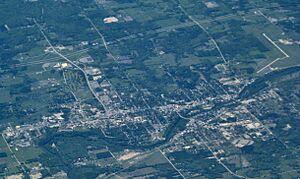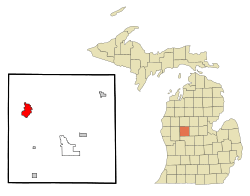Big Rapids, Michigan facts for kids
Quick facts for kids
Big Rapids, Michigan
|
|
|---|---|

Aerial photograph of Big Rapids in 2009
|
|
| Nickname(s):
"B.R."
|
|

Location of Big Rapids, Michigan
|
|
| Country | |
| State | |
| County | Mecosta |
| Incorporated | 1869 |
| Area | |
| • Total | 4.56 sq mi (11.82 km2) |
| • Land | 4.45 sq mi (11.51 km2) |
| • Water | 0.12 sq mi (0.30 km2) |
| Elevation | 925 ft (282 m) |
| Population
(2020)
|
|
| • Total | 7,727 |
| • Density | 1,738.36/sq mi (671.13/km2) |
| Time zone | UTC-5 (Eastern (EST)) |
| • Summer (DST) | UTC-4 (EDT) |
| ZIP code |
49307
|
| Area code(s) | 231 |
| FIPS code | 26-08300 |
| GNIS feature ID | 1619197 |
Big Rapids is a city and the seat of government of Mecosta County, Michigan. The population was 7,727 at the 2020 census, down from 10,601 in 2010. The city is surrounded by Big Rapids Charter Township but they are completely separate jurisdictions. Big Rapids is home of the main campus of Ferris State University, a four-year public university.
Contents
History
Big Rapids was settled in 1855 by George French and his brother Zera. It became the seat of Mecosta County in 1859. The village was platted in 1859. It was incorporated as a city in 1869.
Geography
According to the United States Census Bureau, the city has a total area of 4.48 square miles (11.60 km2), of which 4.36 square miles (11.29 km2) is land and 0.12 square miles (0.31 km2) is water. Like most of the central Michigan area, it lies on the ancient sea bed and has a sandy subsoil which lies above an iron ore base. The Muskegon River runs through Big Rapids, passing both Ferris State University and the local middle school on its way to Lake Michigan. Numerous small lakes are within a few miles of the city.
Transportation
Major highways
 US 131
US 131


 Bus. US 131
Bus. US 131 M-20
M-20 B-96
B-96
Bus
- Indian Trails provides daily intercity bus service between Grand Rapids and Petoskey, Michigan. The southbound bus stops in Big Rapids at 2:35 pm, and the northbound bus stops in Big Rapids at 6:03 pm. Since August 1, 2014, buses stop in the Save-A-Lot parking lot across the street from the Racquet & Fitness Center.
- Public dial-a-ride bus service is provided by the Big Rapids Dial-A-Ride.
Airports
- Roben-Hood Airport is located two miles (3.2 km) north of the Big Rapids business district and provides services to businesses and general aviation throughout the Midwest.
- Gerald R. Ford International Airport is the nearest international airport, located roughly one hour south of Big Rapids near Grand Rapids.
Cycling and hiking
The Fred Meijer White Pine Trail, a 92-mile (148 km) multi-use trail from Grand Rapids to Cadillac, passes through Big Rapids.
Demographics
| Historical population | |||
|---|---|---|---|
| Census | Pop. | %± | |
| 1870 | 1,237 | — | |
| 1880 | 3,552 | 187.1% | |
| 1890 | 5,303 | 49.3% | |
| 1900 | 4,686 | −11.6% | |
| 1910 | 4,519 | −3.6% | |
| 1920 | 4,558 | 0.9% | |
| 1930 | 4,671 | 2.5% | |
| 1940 | 4,987 | 6.8% | |
| 1950 | 6,736 | 35.1% | |
| 1960 | 8,686 | 28.9% | |
| 1970 | 11,995 | 38.1% | |
| 1980 | 14,361 | 19.7% | |
| 1990 | 12,603 | −12.2% | |
| 2000 | 10,849 | −13.9% | |
| 2010 | 10,601 | −2.3% | |
| 2020 | 7,727 | −27.1% | |
| U.S. Decennial Census | |||
Population decline
Big Rapids' population peaked in the 1980s. Since the 1980s, Big Rapids has lost over 46% of its population. There are a number of reasons for the decline, one being the decline in enrollment at Ferris State University. Quality of life concerns have also played a role. .....
2020 census
As of the census of 2020, there were 7,727 people, 3,085 households, and 1,044 families living in the city. The population density was 1,738.4 inhabitants per square mile (671.2/km2). There were 3,590 housing units at an average density of 806.7 inhabitants per square mile (311.5/km2). The racial makeup of the city was 83% White, 5.8% African American, 0.5% Native American, 2.1% Asian, 1.4% from other races, and 7.2% from two or more races. Hispanic or Latino residents of any race were 5.1% of the population.
There were 3,085 households, of which 22.3% had children under the age of 18 living with them, 21.5% were married couples living together, 10% had a female householder with no husband present, 2.4% had a male householder with no wife present, and 66.2% were non-families. 42.3% of all households were made up of individuals, and 13.5% had someone living alone who was 65 years of age or older. The average household size was 2.09 and the average family size was 2.91.
The median age of the city was 22 years. 12.8% of residents were under the age of 18; 51.2% were between the ages of 18 and 24; 17.6% were from 25 to 44; 10.7% were from 45 to 64; and 7.7% were 65 years of age or older. The gender makeup of the city was 53.7% male and 46.3% female.
2010 census
As of the census of 2010, there were 10,601 people, 3,330 households, and 1,323 families living in the city. The population density was 2,431.4 inhabitants per square mile (938.8/km2). There were 3,623 housing units at an average density of 831.0 per square mile (320.9/km2). The racial makeup of the city was 88.0% White, 6.8% African American, 0.7% Native American, 1.5% Asian, 0.6% from other races, and 2.5% from two or more races. Hispanic or Latino of any race were 2.4% of the population.
There were 3,330 households, of which 22.2% had children under the age of 18 living with them, 22.9% were married couples living together, 12.7% had a female householder with no husband present, 4.2% had a male householder with no wife present, and 60.3% were non-families. 36.5% of all households were made up of individuals, and 9.8% had someone living alone who was 65 years of age or older. The average household size was 2.22 and the average family size was 2.88.
The median age in the city was 21.8 years. 12.5% of residents were under the age of 18; 54% were between the ages of 18 and 24; 15.9% were from 25 to 44; 11.2% were from 45 to 64; and 6.5% were 65 years of age or older. The gender makeup of the city was 51.0% male and 49.0% female.
Climate
This climatic region has large seasonal temperature differences, with warm to hot (and often humid) summers and cold (sometimes severely cold) winters. According to the Köppen Climate Classification system, Big Rapids has a humid continental climate, abbreviated "Dfb" on climate maps.
| Climate data for Big Rapids, Michigan | |||||||||||||
|---|---|---|---|---|---|---|---|---|---|---|---|---|---|
| Month | Jan | Feb | Mar | Apr | May | Jun | Jul | Aug | Sep | Oct | Nov | Dec | Year |
| Mean daily maximum °C (°F) | −3 (26) |
−3 (27) |
2 (36) |
11 (52) |
18 (65) |
24 (75) |
27 (80) |
26 (78) |
21 (69) |
14 (57) |
5 (41) |
−1 (30) |
12 (53) |
| Mean daily minimum °C (°F) | −12 (11) |
−13 (9) |
−8 (18) |
−1 (30) |
5 (41) |
11 (52) |
13 (56) |
12 (54) |
9 (48) |
3 (38) |
−3 (27) |
−8 (17) |
1 (33) |
| Average precipitation mm (inches) | 43 (1.7) |
41 (1.6) |
48 (1.9) |
69 (2.7) |
76 (3) |
79 (3.1) |
74 (2.9) |
74 (2.9) |
89 (3.5) |
71 (2.8) |
69 (2.7) |
43 (1.7) |
770 (30.4) |
| Source: Weatherbase | |||||||||||||
Notable people
- Matt Borland, NASCAR crew chief
- Justin Currie, NFL player; raised in Big Rapids
- May Erlewine, musician
- Ben Hebard Fuller, major general and Commandant of the Marine Corps; born in Big Rapids
- Clint Hurdle, outfielder with four MLB teams; manager of the Colorado Rockies and Pittsburgh Pirates; born in Big Rapids
- James Hynes, novelist; grew up in Big Rapids
- Tom Shanahan, a sportswriter and author; grew up in Big Rapids
- Anna Howard Shaw, a leader of the women's suffrage movement in the nineteenth century; lived in Big Rapids as a young woman
- Daisy Tapley, African American classical singer; born in Big Rapids
Education
- Big Rapids Public Schools
- Crossroads Charter Academy
- Ferris State University
- St. Peter's Lutheran Church and School
- St. Mary's Catholic School
See also
 In Spanish: Big Rapids para niños
In Spanish: Big Rapids para niños



